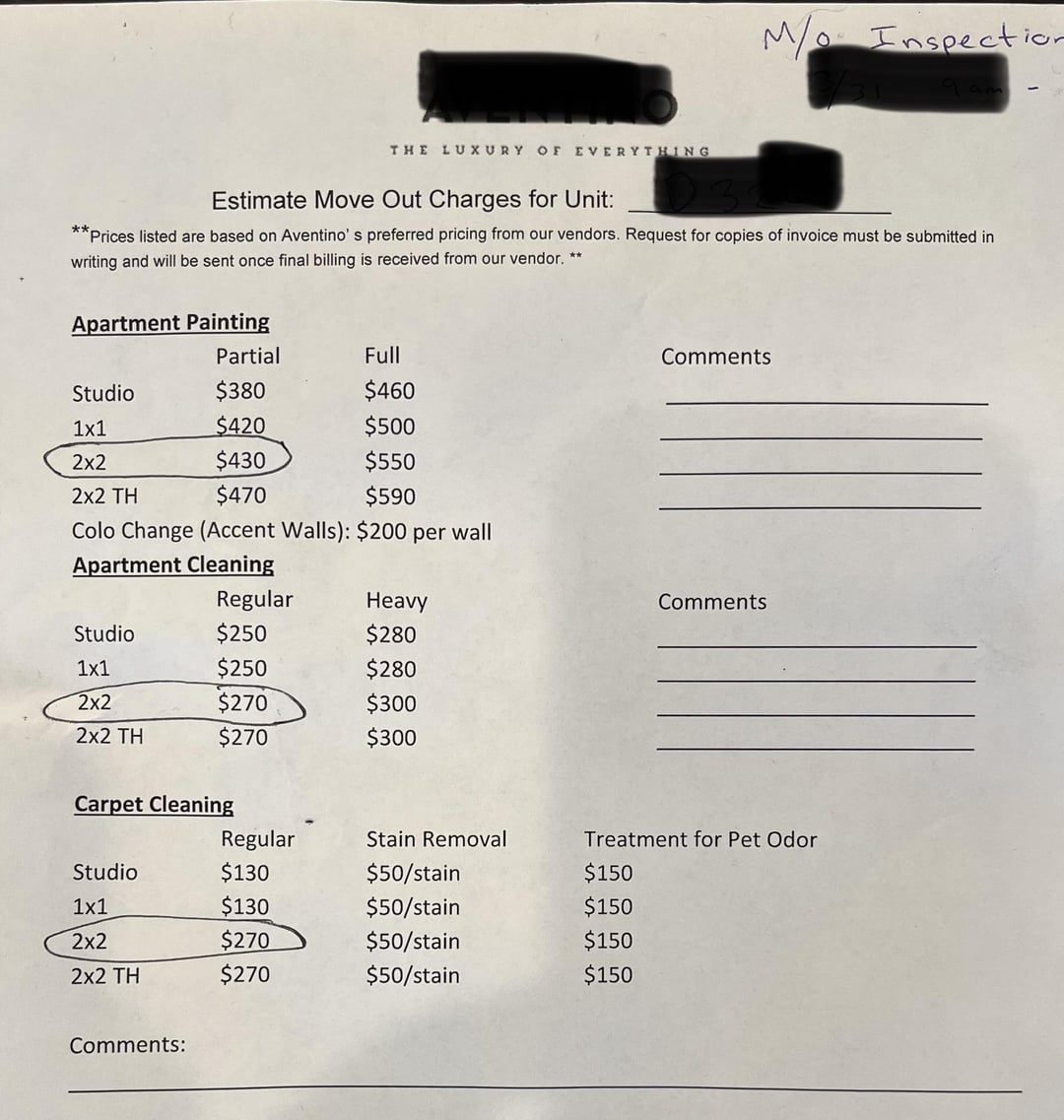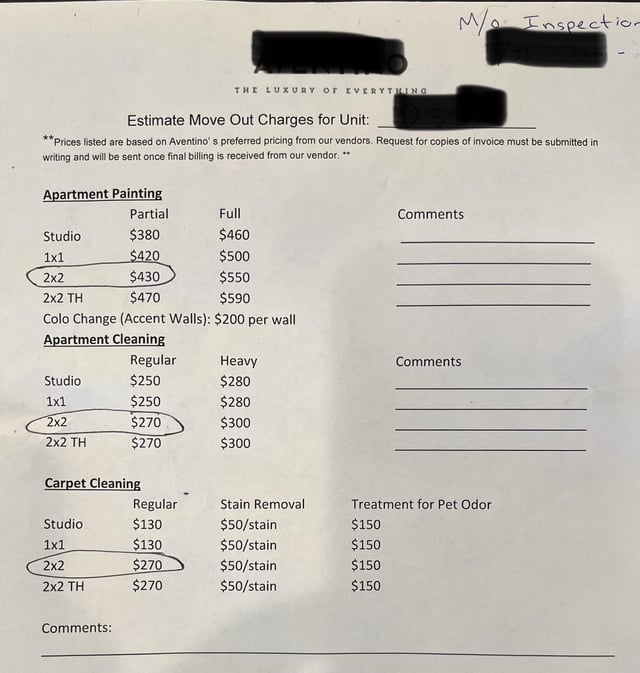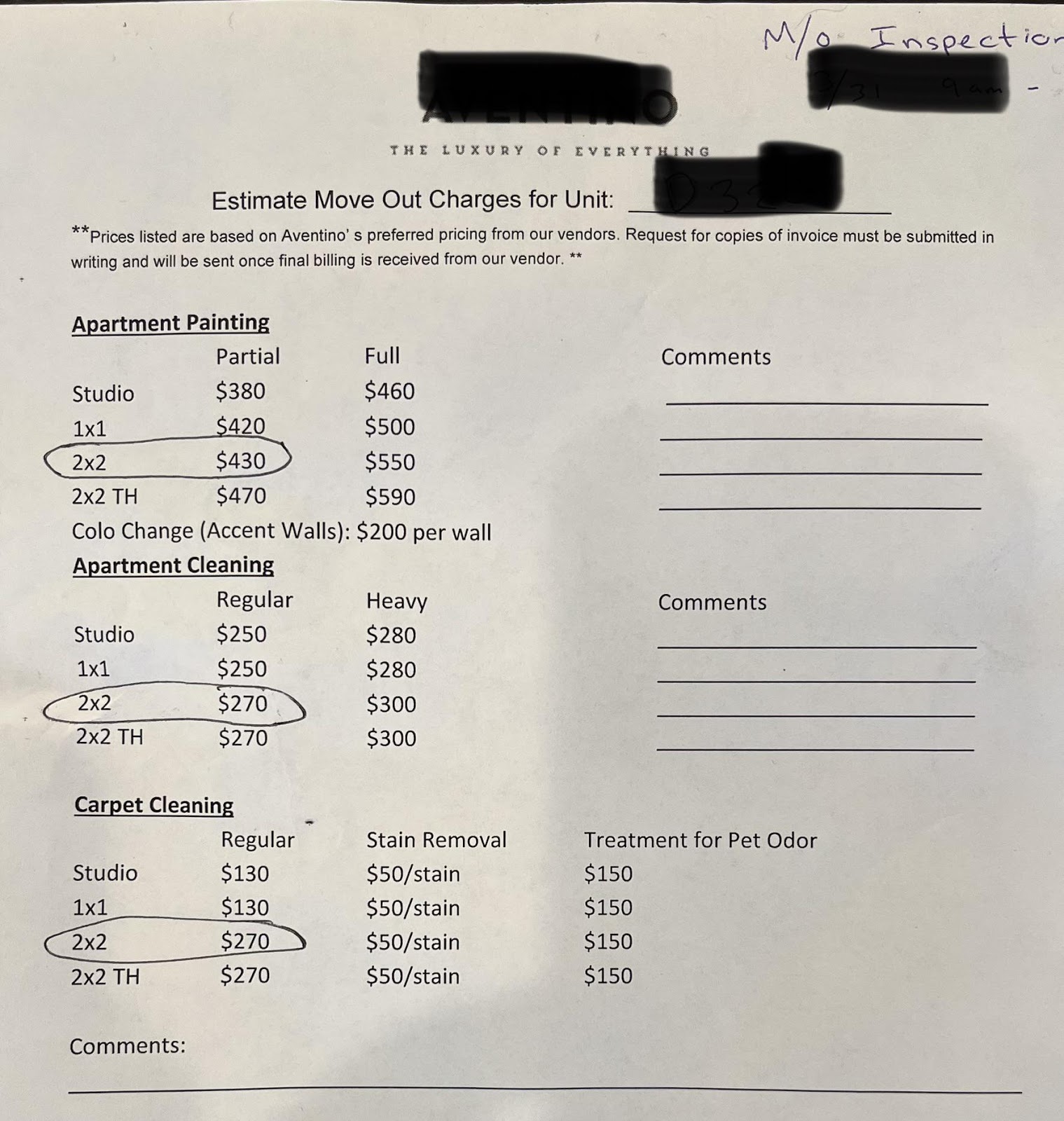Yes, a landlord can charge for cleaning after you move out. But there are rules and conditions that apply.
Understanding these can help you avoid unnecessary charges. Moving out can be stressful. You pack, plan, and then wonder about the final inspection. Will you get your deposit back? Many tenants face this uncertainty. Cleaning fees often surprise them. Landlords have the right to a clean property.
But they can’t charge unfairly. Learn what to expect. Know your rights. This knowledge can save you money and ensure a smooth move. Let’s explore the details of post-move-out cleaning fees.

Cleaning Expectations
When moving out of a rental property, understanding cleaning expectations is crucial. Landlords have certain standards and guidelines that tenants must follow to avoid extra cleaning charges. Knowing these expectations can save you time and money.
To Get The Best Move Out Cleaning Service – Click Here
General Standards
Landlords usually expect the property to be in a similar condition as it was when you moved in. This means normal wear and tear is acceptable, but excessive dirt or damage is not. Here are some general cleaning standards you should follow:
- Floors: Vacuum carpets and mop hard floors.
- Walls: Remove any scuff marks or stains.
- Windows: Clean inside and out, if accessible.
- Kitchen: Wipe down countertops, cabinets, and appliances.
- Bathrooms: Scrub sinks, toilets, bathtubs, and showers.
- Trash: Remove all garbage and recyclables.
Let’s break down some of these tasks in a bit more detail:
| Area | Task |
| Floors | Vacuum all carpets and mop all hard floors. |
| Walls | Clean off all scuff marks and stains. |
| Windows | Wash windows inside and outside. |
| Kitchen | Clean countertops, cabinets, and all appliances. |
| Bathrooms | Scrub sinks, toilets, bathtubs, and showers. |
Move-out Guidelines
Following specific move-out guidelines can help ensure you meet the landlord’s cleaning expectations. Here are some steps to follow:
- Inspection: Schedule a walk-through with your landlord.
- Checklist: Use a cleaning checklist to ensure nothing is missed.
- Repairs: Fix minor damages like holes in walls or broken fixtures.
- Documentation: Take photos of the cleaned property for your records.
- Keys: Return all keys and access cards to your landlord.
Having a detailed cleaning checklist can help:
- Clean all floors and carpets.
- Wipe down all surfaces, including kitchen and bathroom.
- Clean inside all appliances.
- Wash windows and blinds.
- Remove all personal items and trash.
By adhering to these guidelines, you can ensure a smooth move-out process. This can help you avoid unnecessary cleaning charges from your landlord.
Lease Agreement Terms
Moving out of a rental property can be a stressful time. One common question is whether a landlord can charge for cleaning after you move out. The answer often lies in the lease agreement terms you signed at the beginning of your tenancy. Understanding these terms can help you avoid unexpected cleaning fees.
Cleaning Clauses
Lease agreements often include specific clauses about cleaning responsibilities. These cleaning clauses outline the tenant’s duties for keeping the property clean and in good condition. Here are some common points found in cleaning clauses:
- General cleanliness: Tenants must keep the property clean and free from debris.
- Specific areas: Some agreements specify areas like carpets, kitchens, and bathrooms.
- Professional cleaning: Some leases require professional cleaning before moving out.
Reading these clauses carefully is crucial. They can vary widely from one lease to another. For instance, some leases might require professional carpet cleaning. Others might only ask for basic cleaning. Below is an example of what a cleaning clause might look like:
| Clause Type | Description |
| General Cleaning | Tenant must clean all surfaces, including floors and counters. |
| Professional Cleaning | Tenant must hire a professional cleaner for carpets and upholstery. |
| Specific Areas | Tenant must clean specific areas like the kitchen and bathroom thoroughly. |
Understanding these clauses helps you meet your obligations. It also prevents disputes with your landlord when you move out.
Security Deposit Impact
The condition of the property when you move out can affect your security deposit. Landlords use the security deposit to cover any unpaid rent or damages. They can also use it to pay for cleaning if the property is not left in the agreed-upon condition. Here are some ways cleaning can impact your security deposit:
- Full refund: If the property is clean and free from damage, you might get your full deposit back.
- Partial deduction: If minor cleaning is needed, the landlord might deduct a small amount.
- Major deduction: If extensive cleaning is required, a significant portion of your deposit could be withheld.
Here is a simple table showing potential security deposit outcomes:
| Property Condition | Deposit Outcome |
| Clean and undamaged | Full refund |
| Minor cleaning needed | Partial deduction |
| Extensive cleaning required | Major deduction |
To ensure you get the most from your security deposit, follow these tips:
- Review your lease agreement for specific cleaning requirements.
- Perform a thorough cleaning before you move out.
- Consider hiring professional cleaners if required by your lease.
By understanding your lease agreement and taking the necessary steps, you can avoid unnecessary cleaning fees and protect your security deposit.
Normal Wear And Tear
When moving out of a rental property, many tenants wonder if their landlord can charge them for cleaning. It’s important to understand the difference between normal wear and tear and actual damage or excessive dirtiness. This distinction can determine whether you’ll be billed for cleaning costs.
To Get The Best Move Out Cleaning Service – Click Here
Definition
Normal wear and tear refers to the natural deterioration that occurs over time in a property, even with proper maintenance. This includes minor, everyday damage that is unavoidable with regular use.
For example, consider the following:
- Fading paint on the walls due to sunlight exposure.
- Slightly worn carpets in high-traffic areas.
- Minor scuff marks on floors or walls.
- Loose door handles or hinges due to frequent use.
- Small nail holes from hanging pictures or decorations.
These issues are considered normal and are typically the landlord’s responsibility to address between tenants. They are part of the property’s expected lifecycle and don’t result from negligence or mistreatment by the tenant.
Landlords cannot charge for these types of repairs or cleaning, as they fall under the category of normal wear and tear. Instead, they should anticipate and budget for these maintenance tasks as part of their routine property management duties.
Examples
Understanding what constitutes normal wear and tear can help you differentiate it from damage that might incur cleaning charges. Here are some common examples:
- Carpet Wear: A carpet that has become slightly matted or faded over time is normal. However, large stains, burns, or tears are not.
- Wall Marks: Minor scuffs or discoloration from furniture are expected. Large holes, deep gouges, or excessive dirt are not.
- Appliance Use: Normal wear on kitchen appliances, such as a slightly scratched stove or worn-out refrigerator seal, is acceptable. Broken or missing parts, or appliances not functioning due to misuse, are not.
- Bathroom Fixtures: Minor rust or water stains in the bathroom from regular use are normal. Mold growth due to poor cleaning habits is not.
To further clarify, here is a table differentiating normal wear and tear from tenant-caused damage:
| Normal Wear and Tear | Tenant-Caused Damage |
| Faded paint | Crayon marks on walls |
| Worn carpet in hallways | Burn holes in carpet |
| Loose door handle | Broken door lock |
| Minor scuffs on floors | Deep scratches on floors |
By understanding these distinctions, tenants can better prepare their rental property for move-out and avoid unnecessary cleaning charges.
Landlord Rights
When moving out of a rental property, tenants often wonder about their responsibilities. One common question is whether a landlord can charge for cleaning after a tenant leaves. Understanding landlord rights is key to resolving this issue. Let’s explore these rights.
Charge For Cleaning
Landlords have the right to expect their property to be returned in a clean condition. If a tenant leaves the property dirty, the landlord can charge for cleaning. This charge is usually taken from the security deposit.
Here are some points to consider:
- Normal wear and tear: This includes minor scuffs on walls or light carpet wear. Landlords cannot charge for these.
- Excessive dirt or damage: If the property is excessively dirty or damaged, the landlord can charge for cleaning or repairs.
- Checklist: Many landlords use a checklist to document the property’s condition before and after the tenancy. This helps in determining what cleaning is needed.
Landlords must provide an itemized list of cleaning charges. This list should show the cost of each cleaning task. This helps tenants understand the charges and ensures transparency.
In some cases, landlords may hire professional cleaning services. The cost of these services can be passed to the tenant if it is reasonable and necessary. Tenants should be aware of this possibility.
To avoid cleaning charges, tenants should clean the property thoroughly before moving out. This includes:
- Vacuuming carpets
- Cleaning bathrooms and kitchens
- Wiping down surfaces
- Removing trash
Legal Limitations
While landlords have rights, there are legal limitations to what they can charge for cleaning. These limitations are set by state laws and rental agreements.
Here are some legal limitations:
- State laws: Different states have different laws about what landlords can charge. Tenants should familiarize themselves with their state’s laws.
- Reasonable costs: Charges must be reasonable and reflect the actual cost of cleaning. Excessive charges can be disputed.
- Security deposit limits: Some states limit how much of the security deposit can be used for cleaning. Landlords must adhere to these limits.
- Documentation: Landlords must document cleaning charges. This includes receipts and a detailed list of cleaning tasks. Without documentation, tenants can dispute charges.
Tenants have rights too. If tenants believe cleaning charges are unfair, they can dispute them. This can be done through mediation or small claims court. Proper documentation and understanding of state laws help in these disputes.
In summary, while landlords can charge for cleaning, there are legal boundaries. Tenants should be aware of their rights and responsibilities to avoid unnecessary charges.
Tenant Responsibilities
Moving out of a rental property can be stressful. One important aspect tenants need to consider is whether a landlord can charge for cleaning after they move out. Understanding tenant responsibilities is crucial in this regard. Let’s explore what tenants need to do to avoid unexpected cleaning charges.
Pre-move-out Cleaning
Before handing over the keys, tenants should perform a thorough cleaning of the rental property. This helps ensure the property is in good condition and minimizes the risk of cleaning charges. Here are some steps tenants can follow:
- Clean all surfaces: Wipe down countertops, shelves, and other surfaces to remove dust and grime.
- Vacuum and mop floors: Ensure all carpets are vacuumed and hard floors are mopped.
- Bathrooms: Scrub sinks, toilets, and showers. Remove any soap scum or mold.
- Kitchen: Clean appliances, including the oven, stove, and refrigerator. Don’t forget to empty and clean the fridge.
- Windows: Clean the windows inside and out. Ensure window sills are dust-free.
Some landlords provide a checklist to help tenants with pre-move-out cleaning. Following such a list can ensure no areas are missed. Failing to complete these tasks might lead to the landlord hiring a cleaning service and deducting the cost from your security deposit.
Documentation
Documenting the condition of the property before moving out is vital. This can protect tenants if disputes arise about cleaning charges. Here’s how to document effectively:
- Take Photos: Capture clear images of each room, focusing on areas you have cleaned. Include close-ups of any existing damage or wear and tear.
- Video Walkthrough: Record a video walkthrough of the entire property. Narrate what you have cleaned and any pre-existing issues.
- Receipts: If you hire a professional cleaning service, keep the receipt. This can be proof that the property was cleaned to a professional standard.
- Checklist: Complete the landlord’s cleaning checklist, if provided. Sign and date it to show you have addressed all required areas.
Organize these documents and keep copies for your records. Provide a copy to your landlord when you return the keys. Good documentation can prevent misunderstandings and ensure a smooth transition out of the rental property.
Disputes And Resolution
After moving out, many tenants ask, “Can a landlord charge for cleaning?” Disputes about cleaning fees are common. It’s important to know your rights and how to resolve conflicts with your landlord. Understanding the process can save you time and money.
To Get The Best Move Out Cleaning Service – Click Here
Common Conflicts
Disputes about cleaning fees can arise for many reasons. Tenants may feel they left the property in good condition. Landlords may disagree. Here are common conflicts:
- Normal Wear and Tear: Tenants believe the dirt or damage is normal. Landlords may see it as neglect.
- Cleaning Standards: Tenants think the property is clean. Landlords have higher standards.
- Inspection Timing: Disputes occur if landlords inspect long after tenants leave.
- Evidence: Lack of photos or videos from either party can cause disagreements.
Keeping records helps prevent disputes. Take photos before moving out. Document the property’s condition. This evidence can support your case if conflicts arise.
Sometimes, landlords deduct cleaning fees from the security deposit. Tenants may feel the charges are unfair. Understanding lease terms can also help. Review your lease for clauses about cleaning.
Communication is key. Discuss cleaning expectations with your landlord before moving out. This can prevent many misunderstandings.
Mediation Options
If disputes arise, mediation can be a solution. Mediation involves a neutral third party. They help both sides reach an agreement. Here are some mediation options:
- Local Housing Authorities: Many cities have housing authorities. They offer mediation services for landlord-tenant disputes.
- Community Mediation Centers: These centers provide free or low-cost mediation. They help resolve conflicts without legal action.
- Professional Mediators: Hiring a professional mediator can be effective. They charge a fee, but it might be worth it for a fair resolution.
Mediation has benefits. It is usually faster and cheaper than going to court. It also keeps the relationship between tenant and landlord amicable. Both parties can express their views. The mediator helps find a compromise.
To prepare for mediation, gather evidence. Bring photos, videos, and any relevant documents. Clearly state your case. Listen to the landlord’s perspective. Be willing to negotiate. A fair resolution benefits both sides.
If mediation fails, small claims court is an option. But it should be a last resort. It is more time-consuming and costly. Mediation offers a more peaceful path to resolving disputes.
State Laws
When you move out of a rental property, one common question arises: can a landlord charge you for cleaning? The answer often depends on state laws. Different states have different rules and regulations regarding what landlords can and cannot charge tenants. Understanding these laws can help you avoid unexpected charges and disputes.
Variations By State
State laws about cleaning fees can differ significantly. Some states have strict regulations, while others offer more flexibility to landlords. For example:
- California: Landlords can charge for cleaning if the property is not as clean as it was at the start of the lease. They must provide an itemized list of damages and cleaning costs.
- Texas: Cleaning fees are allowed, but the landlord must provide a written notice of the charges within 30 days of moving out.
- New York: Landlords can charge for cleaning only if it exceeds normal wear and tear. They must provide receipts for any cleaning services.
Here’s a table summarizing some state-specific rules:
| State | Cleaning Fee Rules |
| California | Allowed with itemized list |
| Texas | Allowed with written notice |
| New York | Allowed if beyond normal wear and tear |
Key Regulations
Understanding key regulations can help tenants know their rights and responsibilities. Here are some important points:
- Normal Wear and Tear: Most states do not allow landlords to charge for normal wear and tear. This includes minor scuffs or faded paint. It is considered a part of living in the property.
- Itemized Statements: Many states require landlords to provide an itemized list of cleaning charges. This list should detail the cost of each cleaning task. It helps tenants understand what they are being charged for.
- Security Deposit: Cleaning fees are often deducted from the security deposit. Make sure you understand what your deposit covers. This can include unpaid rent, damage repairs, and cleaning fees.
- Notice Period: Some states require landlords to notify tenants of cleaning charges within a specific timeframe. Missing this deadline can forfeit the landlord’s right to charge for cleaning.
Here’s a quick checklist for tenants:
- Check your lease agreement for cleaning fee terms.
- Document the condition of the property when you move in and out.
- Understand what constitutes normal wear and tear.
- Request an itemized list if charged for cleaning.
Knowing these regulations can save you from unfair charges and help you maintain a good relationship with your landlord.

Cleaning Costs
Moving out of a rental property can be stressful. One common question is whether a landlord can charge for cleaning after you leave. Understanding cleaning costs can help you prepare for any potential charges and ensure you get your security deposit back. This section explores typical fees and what an invoice breakdown might look like.
To Get The Best Move Out Cleaning Service – Click Here
Typical Fees
Landlords may charge cleaning fees if the property is not in the same condition as when you moved in. These fees can vary depending on the size of the property and the extent of the cleaning needed. Here are some common charges you might encounter:
- Studio or One-Bedroom Apartment: $100 – $200
- Two-Bedroom Apartment: $150 – $300
- Three-Bedroom House: $200 – $400
In some cases, landlords might have a fixed cleaning fee included in the lease agreement. It’s important to check your lease for any such clauses. If the cleaning required is beyond standard wear and tear, such as deep stains or damage, the costs could be higher.
Cleaning services often include:
- Vacuuming and mopping floors
- Cleaning bathrooms and kitchens
- Dusting surfaces
- Removing trash
- Cleaning windows and mirrors
Knowing these typical fees helps you understand what to expect and possibly avoid these charges by cleaning thoroughly before you move out.
Invoice Breakdown
Receiving a cleaning invoice from your landlord can be daunting. Understanding the breakdown of costs can help you determine if the charges are reasonable. Here’s an example of what a detailed invoice might look like:
| Service | Cost |
| Vacuuming and Mopping | $50 |
| Bathroom Cleaning | $40 |
| Kitchen Cleaning | $50 |
| Dusting | $30 |
| Trash Removal | $20 |
| Window Cleaning | $40 |
Landlords are required to provide an itemized invoice if they deduct cleaning costs from your security deposit. This breakdown should list each service performed and its cost. If you feel any charges are unfair, you have the right to ask for more details or dispute them.
Being aware of these potential costs and ensuring the property is clean can save you money. It also helps ensure a smooth transition when moving out.
Best Practices For Tenants
Moving out of a rental property can be a stressful experience. One question many tenants face is whether a landlord can charge for cleaning after you move out. To avoid unexpected costs, follow these best practices for tenants. Understanding your rights and responsibilities can save you money and ensure a smooth transition.
Final Walkthrough Tips
Final walkthroughs are crucial. They can help you and your landlord agree on the property’s condition. Here are some tips for a successful final walkthrough:
- Schedule in Advance: Schedule the walkthrough with your landlord at least a week before moving out.
- Document Everything: Take photos or videos of each room. Ensure all areas are clean and in good condition.
- Use a Checklist: Create a checklist of items to review during the walkthrough. Include walls, floors, windows, and appliances.
- Bring Cleaning Supplies: Have cleaning supplies on hand for any last-minute touch-ups.
- Be Present: Attend the walkthrough. Address any concerns your landlord may have on the spot.
Here is a sample checklist for your final walkthrough:
| Area | Task |
| Living Room | Vacuum carpets, dust surfaces, clean windows |
| Kitchen | Clean appliances, wipe counters, mop floor |
| Bathroom | Scrub tiles, clean toilet, polish mirrors |
| Bedrooms | Vacuum carpets, dust surfaces, clean windows |
Following these tips can help ensure you leave the property in good condition and avoid cleaning charges.
Preventing Charges
Preventing cleaning charges starts well before moving out. Here are some strategies to help avoid these costs:
- Read Your Lease: Understand the cleaning requirements stated in your lease agreement. Some landlords have specific standards.
- Routine Cleaning: Keep your rental clean throughout your stay. This makes the final cleaning easier and less time-consuming.
- Repair Damages: Fix any minor damages before moving out. This can include patching holes in walls or replacing broken fixtures.
- Hire Professionals: Consider hiring a professional cleaning service. They can ensure your rental meets the required standards.
- Communicate with Your Landlord: Discuss any cleaning concerns with your landlord. They may provide specific instructions or recommendations.
Taking these steps can help you leave your rental in excellent condition. This minimizes the risk of additional charges. Always maintain open communication with your landlord. This ensures a clear understanding of expectations and responsibilities.

Frequently Asked Questions
Can A Landlord Charge For Normal Wear And Tear?
No, landlords can’t charge for normal wear and tear. It includes minor scuffs and small nail holes.
How Much Can A Landlord Charge For Cleaning?
Charges depend on the cleaning required. Typically, landlords charge actual cleaning costs, not exceeding professional cleaning rates.
What If I Cleaned Before Moving Out?
If the property is clean, the landlord shouldn’t charge. Document your cleaning efforts with photos.
Conclusion
Understanding your rights as a tenant is important. Landlords can charge for cleaning. But, they must follow the lease agreement. Always document the property’s condition when you move in. This protects you. Clean well before leaving. This might avoid extra charges.
Communicate with your landlord. Ask for a final walk-through. This can help resolve issues early. Knowing the rules helps keep your rental experience positive. Stay informed and prepared for a smooth move-out process.
